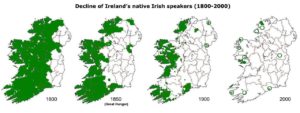Language is an important factor in what is considered to be the ideal Ireland. The Irish Gaelic had dwindled as time passed and there have been revitalization attempts due to the association of Gaelic with Irish Identity.
Language itself is often used as a barrier or a way to oppress. Irish has been no exception and the motive for dehumanizing the Irish people early on was rooted in viewing the language as “barbaric”. The impact of language on how a culture is viewed shifts over time. Irish Gaelic was spoken more when it was considered “barbaric” and then dwindled over time. The continuous decline can be taken from the pressure put on Ireland during the time but then later, the language is seen to be something important for nationality. There is an embrace of the language and its ties to the landscape in which the people hold dear.
The Gaelic League, or Conradh na Gaeilge, was a significant establishment founded in 1893 to revive the language. Classes ran all across the country that led a standardized way to reading and speaking. There were many works also published in Gaelic during this time of the Irish Revival.
Douglas Hyde was a prominent figure in the Gaelic Literary Revival and published A Literary History of Ireland. This book was a good example of how the Gaelic League functioned due to it’s progression through time from an Irish perspective. “Who were those Celts, of whose race the Irish are to-day perhaps the most striking representatives, and on whose past the ancient literature of Ireland can best throw light?” (Hyde 1). The quotation brings with it a connotation of the leadership and merit of Ireland as well as the place in which these proud people of today have garnered their strong will. Hyde ends his book by exposing how the language is a failure because the education system has failed to promote it. He says about the system, “But even with the smallest philological regard for the meaning of words, it cannot be called education” (Hyde 637).
As language is held in high regard because of its association to Irish identity, many leaders have continuously brought the subject to the forefront of Irish politics. The problem with this mainstreamed view of the language is that it can e used to ostracize and punish, or it can be used to bolster national identity. Eamon De Valera in the 1943 speech The Ireland That We Dreamed of, relied on the comeback of Gaelic for the revitalization of an independent Ireland. While this isn’t negative on its own, people who did not speak the language felt left out as De Valera put responsibility on the individual to constantly use Gaelic. Those who disagreed with De Valera could be considered opposed to nationalism and an independent Ireland. This narrow margin for authentic Irish is very exclusive to people who agree and support De Valera’s methods. De Valera also titled his speech in a way that the language is associated with the beauty and good-nature Ireland, placing people who do not speak Gaelic as someone who opposes Ireland altogether. The revitalization argument can be supported with seeing how the prevalence of the language has been constantly decreasing.
There is even an association called the Gaelic League in Detroit that serves to preserve and promote Irish culture or tradition. While not exactly the same, it is interesting to see a comparison in America to the Gaelic League in Ireland. The reason for bringing up this website is the expression of Irish Identity outside of Ireland itself. From someone like De Valera, there is no authenticity because the true Irish is tied to the landscape and to an extreme nationality. This is again exclusive, leaving out a greta number of Irish people who have emigrated and want to be included in their heritage. Does De Valera agree with these people outside of Ireland speaking the language or does revitalization only have a place in the actual country? Language allows for a sense of place and folks outside of the actual country of Ireland can still want that feeling. The tie into Irish culture is prevalent, even in places like Detroit (among others). Their website can be found here.
Click here to return to front page.


